Laurie Fraser's Blog, page 8
December 20, 2014
Happy Solstice!
Winter Solstice
We cannot know light without knowing darkness. We cannot know abundance without knowing lack. Contraction teaches expansion, fear teaches love. Opposites. Our reality is a study of duality. Our loneliness is a yearning for unity.
“Your hand opens and closes, and opens and closes.
If it were always a fist or always stretched open
you would be paralyzed.
Your deepest presence
is in every small contraction and expansion,
the two as beautifully balanced and coordinated
as bird wings.”
– Rumi
This season of lack is not to be despised or feared or negated. This is a time to appreciate the cycles of our lives, this moment in this season.
I see Christmas hoopla as a vain attempt to stamp out the days of darkness and scarcity: the blinking lights, the noise, the excess and over-indulgence. Many people speak of a feeling of emptiness that accompanies the frenzy, and a fatigue that pervades. That was my experience too.
It has taken some years and some effort for me to welcome this time of darkness. It was a challenge to love the darkness as much as the light, not to fight it but to accept its turn. There is something simple about dearth, something sacred about the stillness. It is, after all, a time of rest: hibernation and fasting.
I celebrate Winter Solstice by giving up electricity for the day, burning candles and using the woodstove for heat and cooking. I will smudge the house with white sage. I will walk in the wintery woods and feed the chickadees and nuthatches and squirrels. I will stand at the edge of the river at dusk and thank God for the beauty of Mother Earth and my time here. I will be serving local winter foods- potato latkes, borscht and bread, hard cheese and pickles. In summer, I bottle one jar of fresh peaches especially for the longest night- a light taste that reassures me: summer solstice is on its way now, and the days will steadily lengthen.
I wish you deep rest and quiet peace these dark days of winter.

Mud Lake
The post Happy Solstice! appeared first on Laurie Fraser.
December 14, 2014
Treating Lyme Disease

I like you
Lyme Disease Treatment by Laurie Fraser
edited (shorter) version first published by Tone Magazine Summer 2012
Ahh… my old friend lyme has come to visit me again. After 6 years of health, it has re-emerged, as lyme is wont to do. Well, it’s not the mystery that it was 8 1/2 years ago. It took days to diagnose this time, as opposed to 15 months last time, and I expect to heal rapidly.
That’s the first hurdle with lyme: diagnosis. The ELISA test is unreliable; get a Western Blot test. Lyme presents differently in all of us but often includes deep fatigue, night sweats, chills, joint pain, muscle ache, swollen glands, Bell’s Palsy, balance issues, brain fog… and more. I have a co-infection as well—Babesia—so add headache, shortness of breath and nausea. Other common co-infections are Bartonella and Ehrlichia.
So what to do? My doctor says Ottawa is a hotbed for lyme (caused by a tick bite) and I have several clients recovering from it. I approach it from all angles.
1. Drugs: This is the time to use antibiotics. Generally Doxycycline does the trick but if the lyme is chronic, diagnosed late, or complicated by a co-infection antibiotics might be varied and high-dose. Babesia requires an anti-malarial.
2. Homeopathic remedies: Lyme disease nosode, A-Bab, ledum, pyrogenium, staphosagria, lyme disease nosode. For pain: arnica, ruta and causticum
3. Supplements and vitamins: A, B6, B12, C, D, probiotics, Spirulina, fish oil, Turmeric, Cinnamon, Green tea extract, SAMe, Cat`s Claw (Samento), Serrapeptase, Japanese knotweed, Ginseng tea, bitters, grapefruit seed extract, oregano oil to name a few. Some of these are quite potent and may not be for you—check with a naturopath. Check tissue salts- commonly Kali Phos is required.
4. Food: No to sugar, oil, fats, yeast, gluten
Yes to fresh greens, especially dandelion leaves and parsley, proteins
5. Light work. Visit www.tomkenyon.com (click on Hathors) to learn a simple healing method called `Medicines of Light` that you can do yourself. I did it 3 times for lyme and 9 for babesia.
6. B.O.S. (Biocomputer Operating System) Hundreds of procedures including those for pain and infections. I do this work part time and I`m able to work on myself. I use muscle-testing to communicate with the client`s energy and find my way through menus and sub-menus until I come to a correction that the energy wants. It prioritizes, not I.
In my case, my energy led to:
-anxiety procedure
-affirmations
-boundary work
-chakra balances
-pathogen procedures
-pain (turn to page 25) procedures
7. Spiritual procedures- I build a pillar of light around the treatment table, open the navel, (energetically), and pull out zillions of bacteria who float up the pillar of light where they`re assisted by Archangel Micheal. I send them with love and gratitude. This is not a war. These little visitors have many lessons to teach.
– I use an energetic blue sword given to me by my Ascended Master, El Morya, to clear and to send lightening bolts into the root chakra (a re-boot) and the liver (eases pain).
8. Comprehensive healing (Tone Magazine, June 2012 turn to page 14): In a meditation I grew to a great size and saw a holographic image of myself as a white rabbit. I caught her and held her in my cupped palms, while in a place of Divine love and unity. Light saturated her: green, blues and she became a white rose. I waited and the rose was replaced by an image of fire. The fire eventually became a transparent light, like heat off a road, and I placed this light in my heart.
9. Façade healing (Tone Magazine, Dec. 2010). Divine Teachers and healers come in response to the facade prayer (see Susan Chumsky) and work directly on the client. For me- Jesus came to remove the façade of “invaded“.
10. Powerful reiki by Susan Walker at Mother Earth.
11. Vonner protocol and Cowden’s protocol- good stuff, but expensive. Byron White’s A-L Complex. Again, hard to get and expensive, but effective.
12. AN-DI machine if you can find one.
*** No massage or yoga during systemic infections- it just spreads the bacteria around.
I give thanks to Crow, Blue Jay, El Morya, Jesus, my Ba, Snake, Lynx, Wolf, Mother Mary, and to Archangel Michael and Elohim.
The post Treating Lyme Disease appeared first on Laurie Fraser.
Treating Lyme Disease Energetically
Lyme Disease Treatment
by Laurie Fraser
edited version first published by Tone Magazine Summer 2012
Ahh… my old friend lyme has come to visit me again. After 6 years of health, it has re-emerged, as lyme is wont to do. Well, it’s not the mystery that it was 8 1/2 years ago. It took days to diagnose this time, as opposed to 15 months last time, and I expect to heal rapidly.
That’s the first hurdle with lyme: diagnosis. The ELISA test is unreliable; get a Western Blot test. Lyme presents differently in all of us but often includes deep fatigue, night sweats, chills, joint pain, muscle ache, swollen glands, Bell’s Palsy, balance issues, brain fog… and more. I have a co-infection as well—Babesia—so add headache, shortness of breath and nausea. Other common co-infections are Bartonella and Ehrlichia.
So what to do? My doctor says Ottawa is a hotbed for lyme (caused by a tick bite) and I have several clients recovering from it. I approach it from all angles.
1. Drugs: This is the time to use antibiotics. Generally Doxycycline does the trick but if the lyme is chronic, diagnosed late, or complicated by a co-infection antibiotics might be varied and high-dose. Babesia requires an anti-malarial.
2. Homeopathic remedies: Lyme disease nosode, A-Bab, pyrogenium, staphosagria, for pain: arnica, ruta and causticum
3. Supplements and vitamins: A, B6, B12, C, D, probiotics, Spirulina, fish oil, Turmeric, Cinnamon, Green tea extract, SAMe, Cat`s Claw (Samento), Serrapeptase, Japanese knotweed, Ginseng tea, bitters, grapefruit seed extract, oregano oil to name a few. Some of these are quite potent and may not be for you—check with a naturopath. Check tissue salts- commonly Kali Phos is required.
4. Food: No to sugar, oil, fats, yeast, gluten
Yes to fresh greens, especially dandelion leaves and parsley, proteins
5. Light work. Visit www.tomkenyon.com (click on Hathors) to learn a simple healing method called `Medicines of Light` that you can do yourself. I did it 3 times for lyme and 9 for babesia.
6. B.O.S. (Biocomputer Operating System) Hundreds of procedures including those for pain and infections. I do this work part time and I`m able to work on myself. I use muscle-testing to communicate with the client`s energy and find my way through menus and sub-menus until I come to a correction that the energy wants. It prioritizes, not I.
In my case, my energy led to:
-anxiety procedure
-affirmations
-boundary work
-chakra balance
-pathogen procedures
-pain (turn to page 25) procedures
7. Spiritual procedures- I build a pillar of light around the treatment table, open the navel, (energetically), and pull out zillions of bacteria who float up the pillar of light where they`re assisted by Archangel Micheal. I send them with love and gratitude. This is not a war. These little visitors have many lessons to teach.
- I use an energetic blue sword given to me by my Ascended Master, El Morya, to clear and to send lightening bolts into the root chakra (a re-boot) and the liver (eases pain).
8. Comprehensive healing (Tone Magazine, June 2012 turn to page 14): In a meditation I grew to a great size and saw a holographic image of myself as a white rabbit. I caught her and held her in my cupped palms, while in a place of Divine love and unity. Light saturated her: green, blues and she became a white rose. I waited and the rose was replaced by an image of fire. The fire eventually became a transparent light, like heat off a road, and I placed this light in my heart.
9. Façade healing (Tone Magazine, Dec. 2010). Divine Teachers and healers come in response to the facade prayer (see Susan Chumsky) and work directly on the client. For me- Jesus came to remove the façade of “invaded“.
10. Powerful reiki by Susan Walker at Mother Earth.
11. No massage or yoga during systemic infections- it just spreads the bacteria around.
I give thanks to my guides, teachers and to Archangel Michael.
The post Treating Lyme Disease Energetically appeared first on Laurie Fraser.
Energy healing articles by Laurie Fraser
I regularly publish articles in Tone Magazine about the energy healing work I do.
Cancer and energy healing Tone Magazine Jan. 2013
Pain Tone Magazine Summer 2014 turn to page 25
What’s the Message? Tone Magazine Feb. 2014 turn to page 9
Pillar of Light Tone Magazine Oct. 2012
Something New- Comprehensive Healing June 2012 turn to page 14
The post Energy healing articles by Laurie Fraser appeared first on Laurie Fraser.
November 27, 2014
Pho (pronounced “fow”) Asian noodle soup recipe
Ingredients in bold.
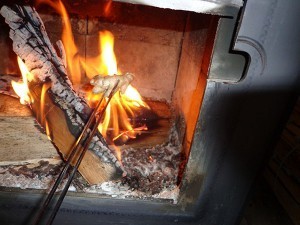
Charring ginger in the wood stove.
Make broth:
1.5 litres of broth (Water with bouillon works fine for me, but my Cambodian friend insists homemade broth from bone is the only way.)
-charred ginger, several garlic cloves, onions or shallots cut in chunks
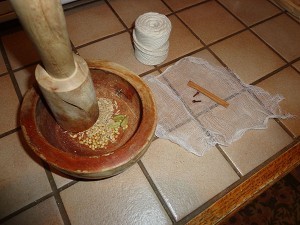
I used cheesecloth to make a spice bag.
-a spice bag (bouquet garni) containing:
1/2 cinnamon stick
1 – 2 whole cloves
8 cardamom pods, cracked
4 tsp each of corriander seed and fennel seed, ground together
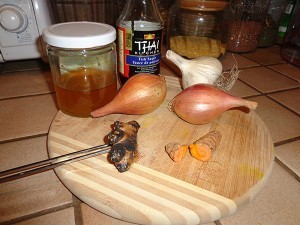
charred ginger, shallots, honey, fish sauce, garlic & fresh turmeric
(I added a bunch of dried basil and ground in a bunch of mustard seeds and 2 tsp. cumin seeds…I can’t resist throwing things in. I also added 1 chopped fresh turmeric root for its anti-inflammatory properties.)
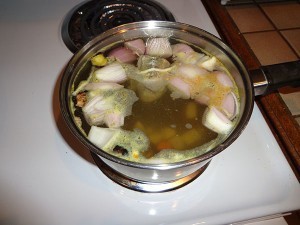
simmering stock
Bring broth to a boil and then simmer- the longer the better- until aromatic. Strain.
Then adjust the taste with the four essentials of Eastern Asian food- salty, sour, hot and sweet. I used lots of fish sauce, lime juice, fresh red chili and raw honey.
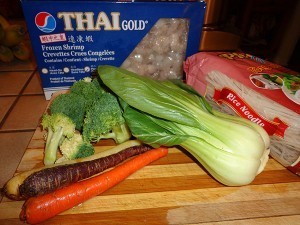
carrots, broccoli, shrimp, rice noodle, bok choy
In a large bowl arrange cooked veggies (broccoli, cauliflower, bok choy- whatever’s in the fridge), cooked rice noodle and a cooked protein (tofu or shrimp or thinly-sliced beef or chicken.)
Pour hot broth over this and serve with your choice of garnishes:
bean sprouts, fresh basil, mint, cilantro, hoisin sauce, chilies, lime.
Enjoy!
The post Pho (pronounced “fow”) Asian noodle soup recipe appeared first on Laurie Fraser.
November 23, 2014
Cultural accommodation.
Canadians pride themselves on tolerating, even celebrating, the multitude of cultures in our land. We are a country of immigrants, none of us here longer than 450 years (except Aboriginals, of course). Many are new arrivals- Canada welcomes 225,000 – 275,000 newcomers a year. In a country with a population of only 35 ½ million, the new arrivals have significant impact.
Newcomers add their culture to the ever-changing Canadian reality. Italian, Chinese, Polish, Indian, Lebanese communities are Canadian, no doubt. The Somali community has become stronger in recent years developing their own community centres and teaching the rest of us about their ways. In Ottawa, Afghani restaurants have appeared in the last 5 years. For me, it’s when the restaurants start sprouting up that I feel an ethnic group is really flourishing in Canada’s tolerant atmosphere.
Of course it’s more than atmosphere- laws, rights and freedoms assure every Canadian the right to speak and worship, congregate and live in their own way.
An Ontario judge recently upheld the right of an Aboriginal parent to use traditional First Nations medicines to heal her sick child, rather than the poison called chemotherapy. By doing so, precedent has been set: mainstream allopathic medicine is not the only legitimate medical model. We have the right in Canada to follow our own values, beliefs and traditions.
So now we come the crux of the matter: individual decisions and attitudes that are, human nature being what it is, sometimes less tolerant than the country’s laws.Quebec has been experiencing charges of racism over its proposed “values charter” that would restrict religious clothing. The federal government vows it would fight such a move. Read more.
Recently mosques have been defaced in Trois Rivieres, Quebec and Cold Lake, Alberta. In Nova Scotia, a grandmother was charged with assault and criminal harassment after attacking a woman for wearing a headscarf at a mall. Read more.
These behaviours are illegal certainly, but what about the attitudes, words and quiet decisions made by individuals every day?
Tolerance is one thing, but let’s go a step further and talk about accommodating people’s beliefs and cultural practices.
Many workplaces allow their employees to celebrate their religious holidays (with pay) regardless of how they line up with traditional Christian holidays. So, Muslims, Buddhists and Hindus get Christmas and Easter off because their workplace is simply not open on those days- they are statutory holidays. They may get Eid or Diwali off as well.
I’ve heard Christians complain about that- even calling it discrimination. “Why does a Hindu get more holidays than I do?” Is there a solution to this? How about calling them Personal Days and letting everyone take them off at their discretion?
As Muslims become a larger part of our population, they may demand their holy day, Friday, off, yet be willing to work Sunday. Can employers accommodate this? Well, a retail store can, a factory can, but an institution like the federal government or a school board cannot.
Airports have prayer rooms; many schools and workplaces have prayer rooms or “quiet” rooms as well. This accommodates some Muslims who have made a religious commitment to pray 5 times a day. My school has such a room and it’s used by more than Muslims. I often go in there at break time, sitting cross-legged and meditating. Sometimes a student will ask what I’m doing. I explain, “I am praying. My prayer looks like this.” The student will smile or touch me in solidarity. We seem to agree in the secluded serene space: all prayer is good.
We have female students who are completely covered with a niqab. Not all coverings are the same- see the many styles and traditions here.
The women wearing a niqab have difficulty eating at lunch time. Our school has several classrooms used as lunch rooms and a kitchen area as well. All are coed. For such women, they cannot lift the niqab to eat in the presence of men. I’ve seen them furtively slip a spoonful of food under the covering into their mouths. I’m also aware of them missing meals because they couldn’t eat with men in the room.
Regardless of why they follow these practices, lunch time is uncomfortable, even stressful for them. When I suggested a “Women’s Only Lunchroom”, school staff reacted both pro and con:
“Yes, they deserve to be comfortable and it’s no trouble to accommodate them.”
“This is discrimination. We cannot be discriminatory.”
“They are here to learn how to integrate in Canada and they won’t be seeing a separate lunch room at their future Canadian workplace or mainstream educational institution. Might as well get used to it now.”
“The practice is abusive and we should not participate or appear to condone it.”
I think it is vital that we examine every decision we make, no matter how small, for judgement. I firmly believe it is not my place to judge another’s beliefs or practices as long as they are not illegal, harmful to self or others.
These women wear the niqab and it is not a decision that requires changing, enlightening or educating. It is a simple fact- their reality. For us to make it difficult for them or to refuse to make life easier for them imposes our beliefs on them. Do we have the right to do that? Yes, of course we do- it doesn’t impinge on their human rights.
Is it fair? That’s a whole other question.
When I lived in Turkey, I often had to do things that were uncomfortable for me. More than that- it was frustrating, even maddening, for me to be confined to the women’s “haremlik” where the women ate separately from the men (in the more traditional households, not everywhere, and not in my own home). I didn’t have the freedom to say, “I am Canadian. Please respect my values and let me eat with the men.”
Was it fair? Well, it didn’t seem fair to me, but when in Rome…
So we have come to an impasse. Some of the staff would like to accommodate the women; some think it is a mistake.
You know, to me, we are not in Rome. We are not in Turkey. We are in Canada- and Canada values holding onto one’s culture and tolerating differences. More than that- we are known to be a people who will go out of our way to be kind. We have a reputation for compassion.
As well, our students are new arrivals, the majority in the last year or two. They are constantly adapting to their adopted country; the new smells, sights and weather are all stressful on the body and brain. On top of that, the shopping, the food, the cultural expectations- everything from being at school on time to the way they discipline their children, from being spoken to by a male at the bus stop to dressing properly for winter- they are all stressful adjustments.
We are a democracy at our school, but we have not been able to come to a consensus, and so leadership is required. I am the manager. The women will have the option of a lunchroom for their use alone. It will be discreet- not a designated room with a sign- just a quiet out-of-the-way place where a few women can find some privacy to eat in comfort.
It’s almost the least we can do.
The post Cultural accommodation. appeared first on Laurie Fraser.
November 20, 2014
Middle Eastern Chicken recipe
Crispy tasty chicken made with zakat.
Zakat is a popular spice combo used in the Middle East, often simply sprinkled on flat bread with olive oil and baked.
Buy Zakat at a Mid-East grocer or mix your own by combining sesame seeds, thyme, sumac and salt.
 Sprinkle chicken pieces on both sides with olive oil and a generous amount of zakat. Marinade at least an hour (in the fridge). I used chicken thighs, but drumsticks and breast strips are yummy too.
Sprinkle chicken pieces on both sides with olive oil and a generous amount of zakat. Marinade at least an hour (in the fridge). I used chicken thighs, but drumsticks and breast strips are yummy too.
Cook at 350 until cooked through and crispy outside, about 30 minutes depending on your choice of cut.
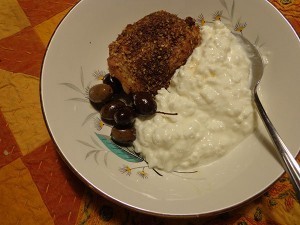
olives, cold Mid-East chicken and cottage cheese
Leftovers are mighty good cold.
The post Middle Eastern Chicken recipe appeared first on Laurie Fraser.
November 18, 2014
Kurdish Culture
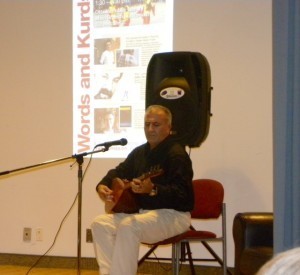
Shahram playing the tanbour.
Kurds are more than the fight.
How often did my husband hold his finger in the air and declare, “We want to speak our language without fear. We want the right to dance, to sing our music, to write and read our literature.”
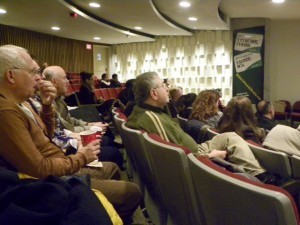
85 + at the Ottawa Public Library
After all, what are they fighting for?
At this moment, in many places, they are fighting for simple survival, a peaceful place to live, clean water, a dry warm bed, a garden, a roof, a safe haven, a border. But more than that- they are fighting for Kurdish schools, Kurdish businesses, Kurdish culture.
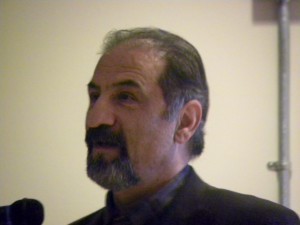
Jaffer Sheyholiislami
We gathered on Nov. 15, almost 100 of us, not to talk about the fight or the people dying on the mountains. We gathered to enjoy the talent of Shahram with his tanbour, the singing and film-making of children in Kobani, the poetry of Jaffer Sheyholislami and other Kurds, and the stories I had to tell about my time in Kurdistan.
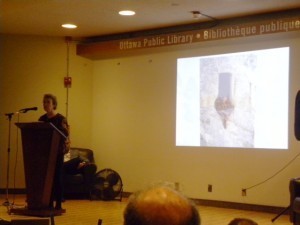
reading about the 3-day wedding
It was a joyous afternoon. A reporter from Centretown News had interviewed me the day beforehand. I had been practicing my speech when she called, but I said with confidence, “I’m not nervous. It can’t go wrong with these people in the room. It’ll be all heart.” How could it be anything but?
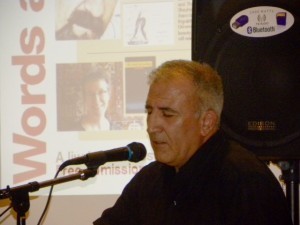
Shahram
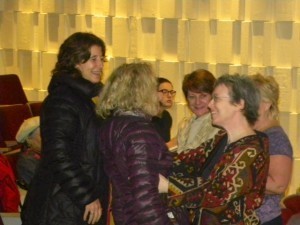
old friends who made the trip
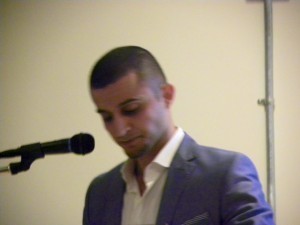
Jeghir Jahangir, mc extraordinaire
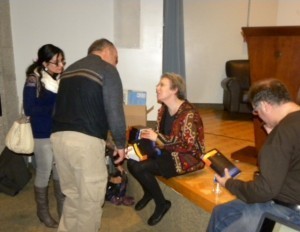
signing
The post Kurdish Culture appeared first on Laurie Fraser.
November 15, 2014
Kurdish poetry
Separation
by Sherko Bekes
From my poems, if you take away flowers,
One of my four seasons will die
If you take away the wind,
Two of my seasons will die.
If you take away bread,
Three of my seasons will die.
If you take away freedom,
My whole year will die,
and so will I.
Translated by Jaffer Sheyholislami
as performed at Words and Kurds Cultural Event, November 15, 2014
The post Kurdish poetry appeared first on Laurie Fraser.










